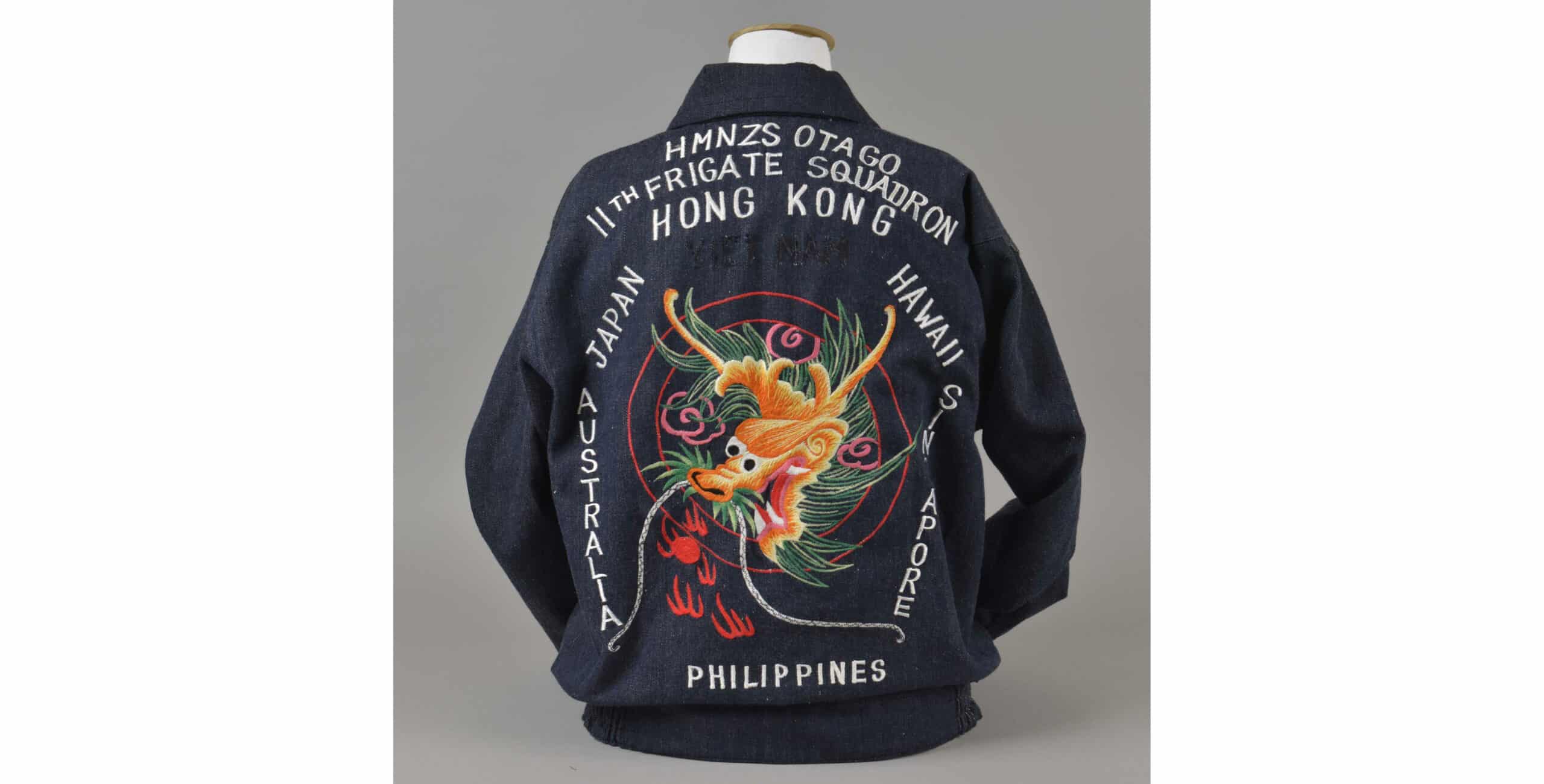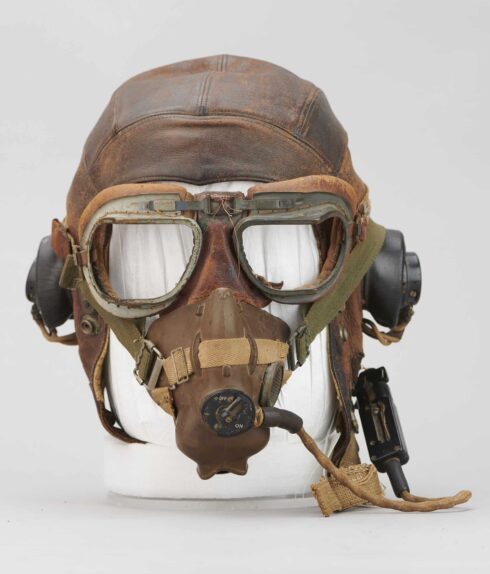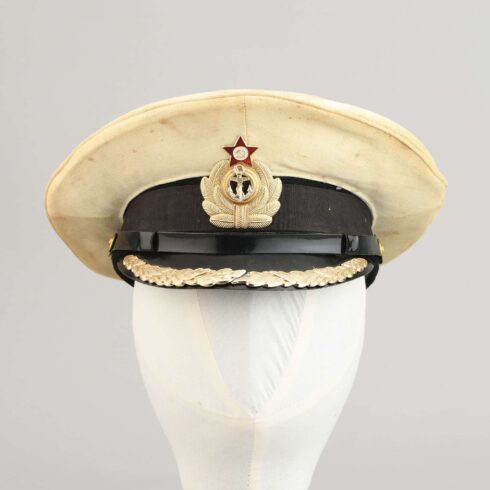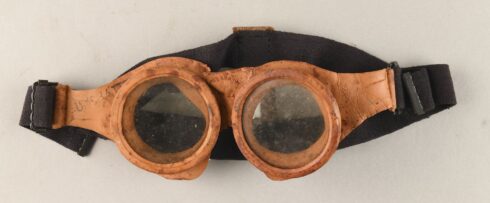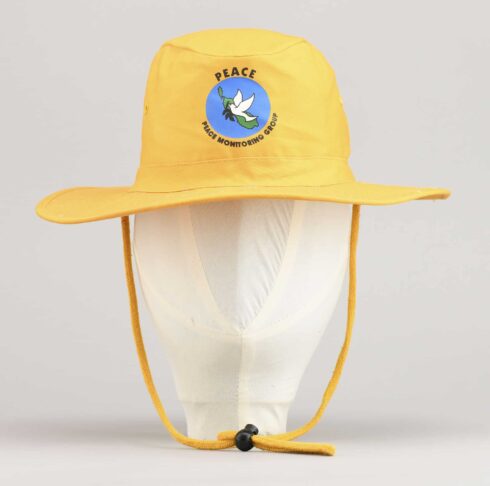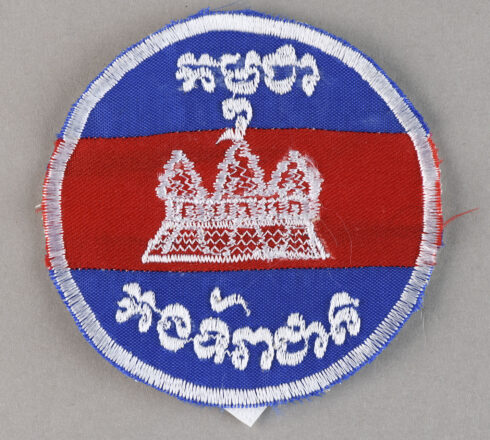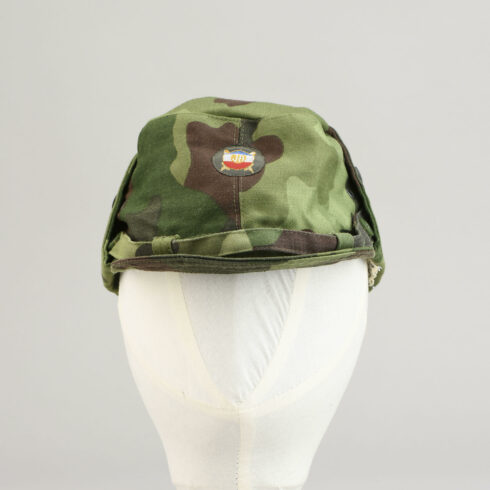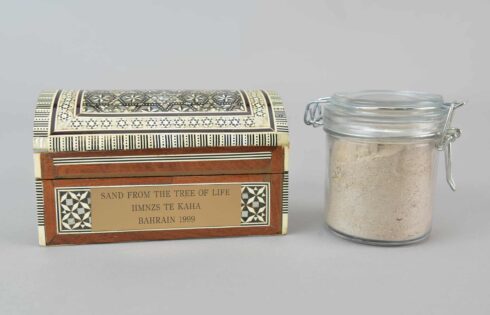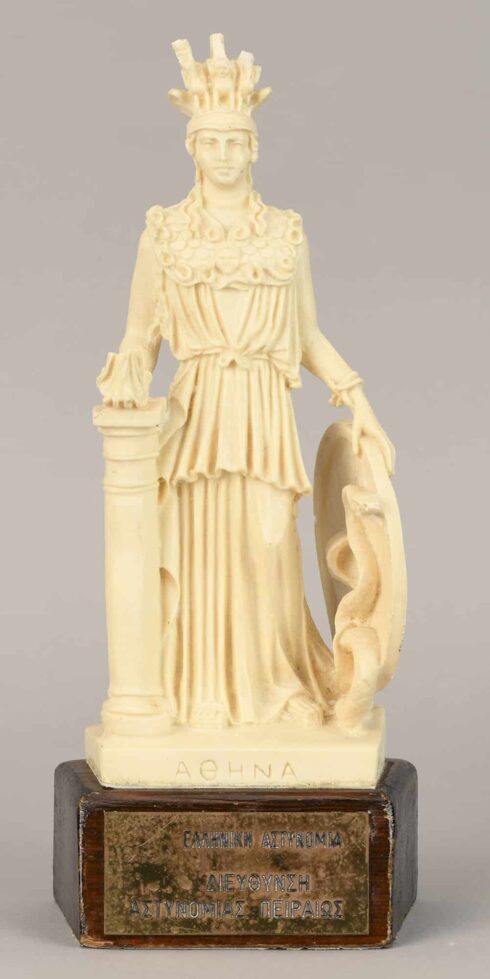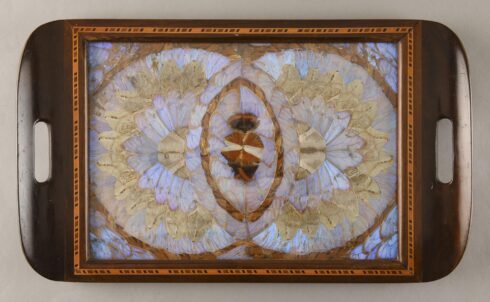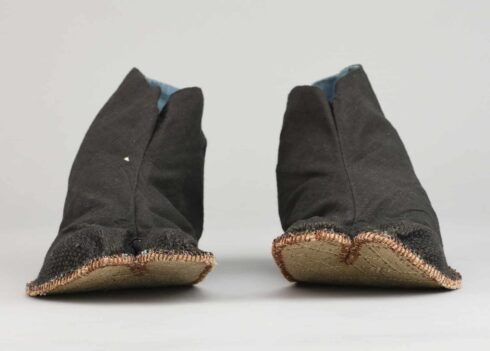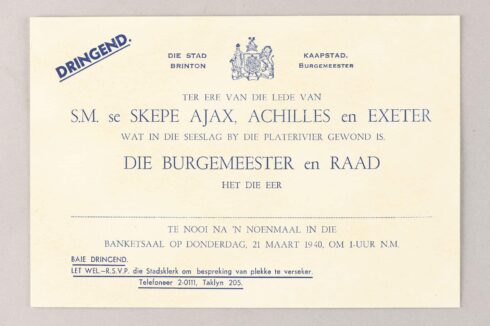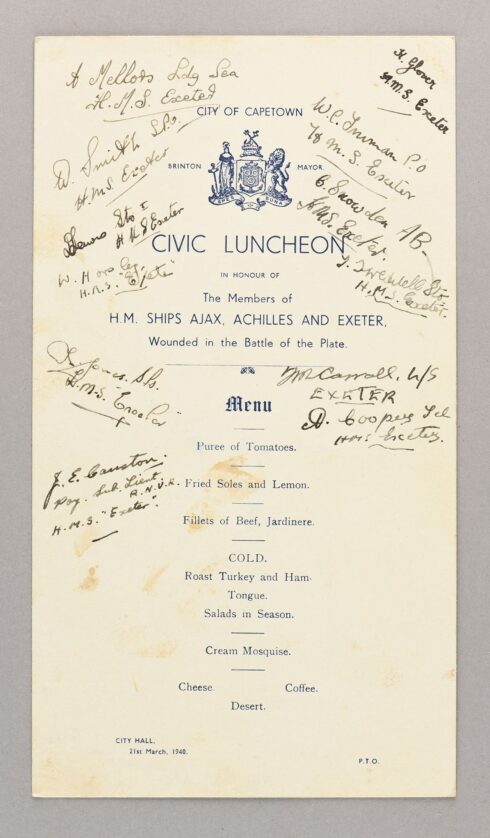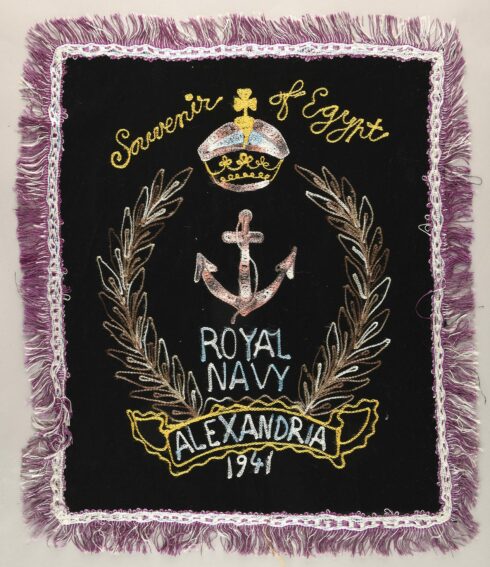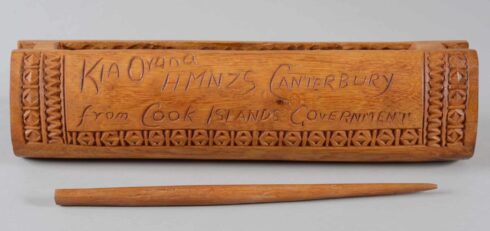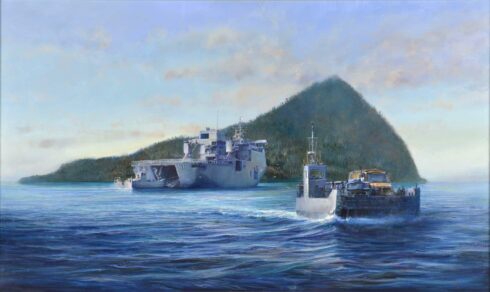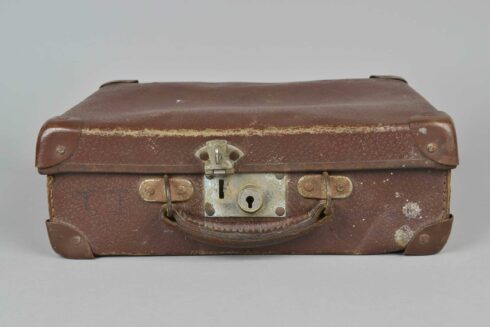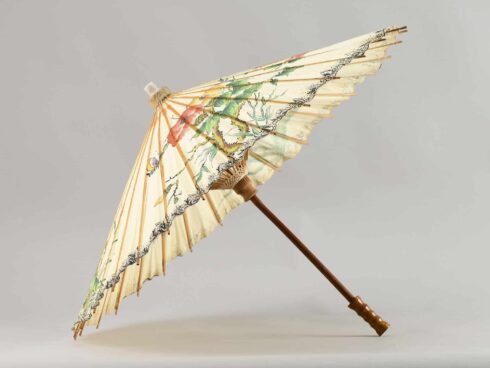Objects From Around the World
From warfare to peacekeeping, to environmental
conservation and disaster relief, the Royal New
Zealand Navy (RNZN) has travelled the world.
This collection of objects represents some of the
many unique global connections forged by the
RNZN. Each gift, artwork, souvenir, and memento
tells a story of Kiwi sailors away from home. Some
are individual stories of dedication, exploration, and
curiosity; others are collective stories of
commemoration, duty, and gratitude.
The RNZN’s global reach continues to this day,
connected by the sea and enabled by the
dedication of those who serve.
Ngā tāonga nо̄ Tāwāhi
Mai i te pakanga ki te hohou i te rongo, te whāomo
taiao me ngā tautoko aituā, kua tae atu Te Taua
Moana (RNZN) ki ngā tōpito katoa o te ao.
E whakaatu ana tēnei kohinga taonga i ētahi o ngā
tūhononga motuhake ā-ao i whakaritea e te RNZN.
Kei ia taonga, ia mahi toi, ia taonga manatunga, he
kōrero mō ngā hēramana o Aotearoa i tāwāhi. Ko
ētahi he kōrero mō te manawanui, te hōpara, me te
manawa reka; ko ētahi he kōrero tōpū mō te
whakamaharatanga, te mahi, me te whakawhetai.
E haere tonu ana te toro a RNZN ki te ao, ko te
moana tonu te hononga, ā, e taea ana nā te
manawanui o te Taua Moana.
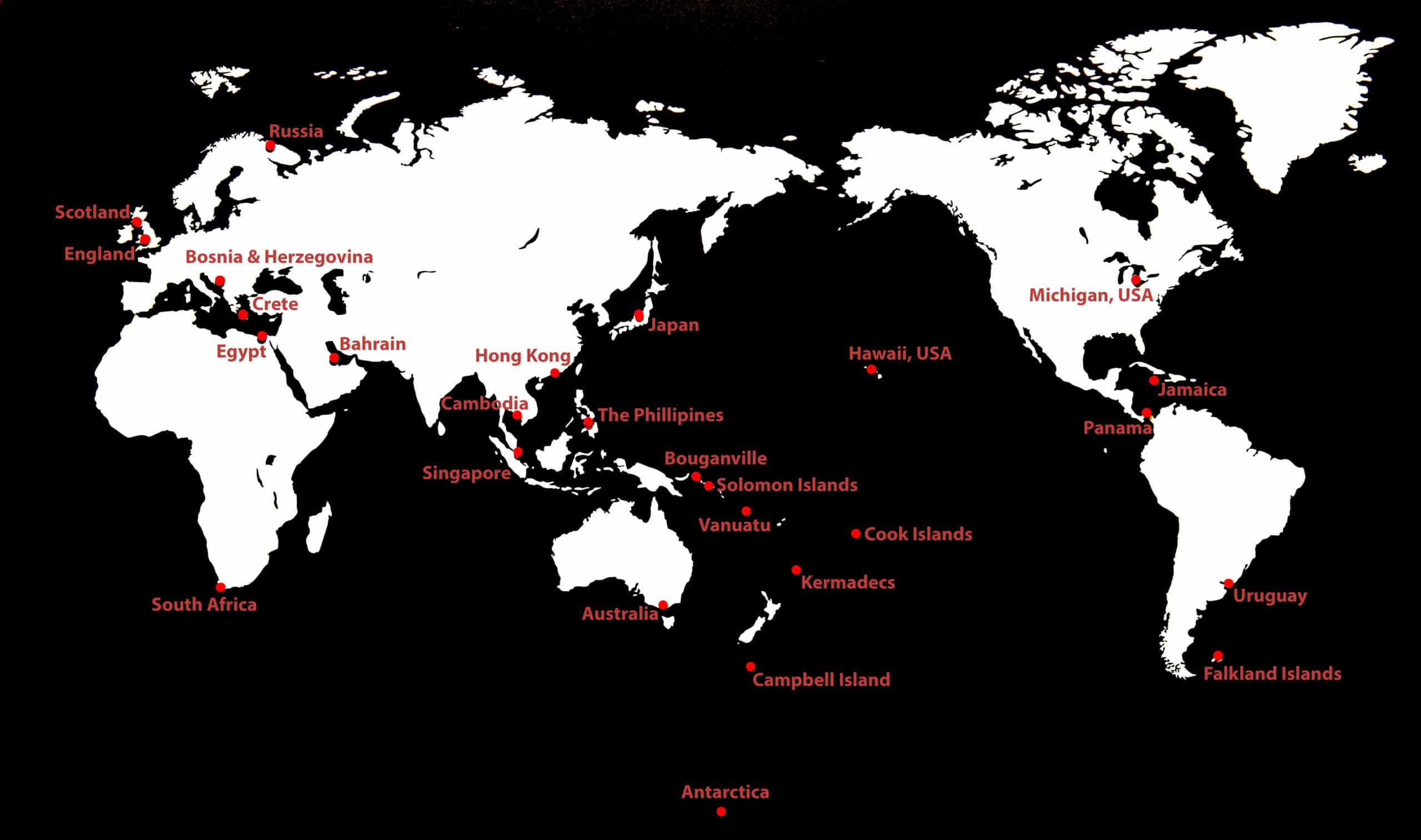
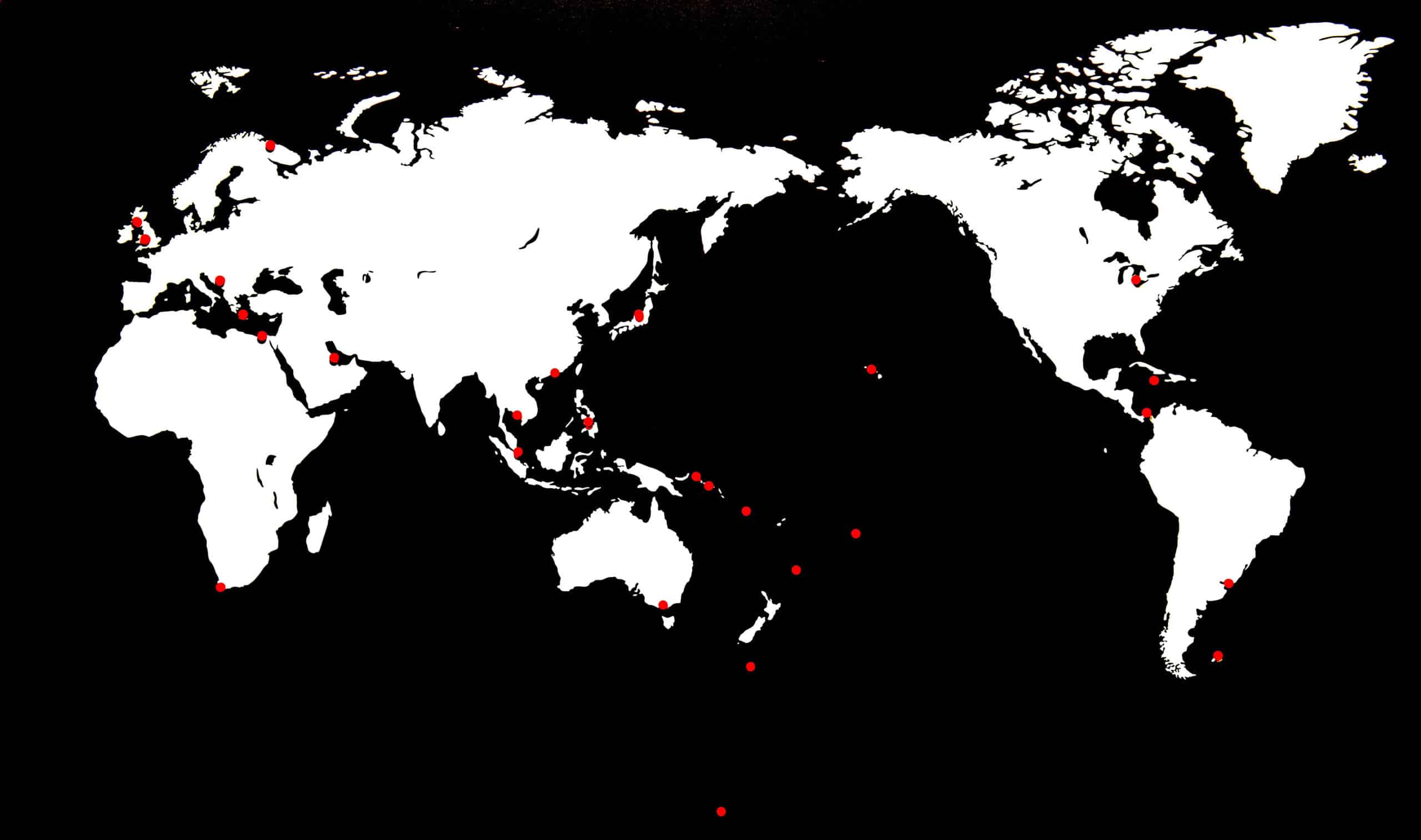
Have a closer look at the different objects which have their origins over seas. Underneath the photo gallery, you can find additional information about how these objects connect to the RNZN’s travels around the world.
Copyright restrictions may apply, please contact the National Museum of the Royal New Zealand Navy for permission to copy or use these images.
Pennant
Decorative pennant with the Royal Australian Navy (RAN) crest. It would likely have been produced as a souvenir for sailors to purchase. Donated to the collection by the Royal Naval Men’s Association, this pennant serves as a symbolic reminder of the close relationship between the Royal New Zealand Navy (RNZN) and the RAN. Since the 1920s the two navies have conducted numerous joint exercises and continue to work collaboratively in areas of mutual interest.
Flying helmet and goggles
This flight headgear belonged to Lieutenant James McAndrew, who joined the Fleet Air Arm (FAA) in 1940. He was sent to England for initial training and went on to fly catapult aircraft such as the amphibious Supermarine Walrus.
During the Second World War New Zealanders made up more than ten percent of the FAA operating across the globe; seeing action in the Indian Ocean, Atlantic Ocean, Mediterranean Sea, and off the coasts of Africa and Europe.
James McAndrew was in the RNZ Naval Volunteer Reserve and after arriving in the UK he was posted to No 14 Elementary Flying Training School at Elmdon, Birmingham, in December 1940. After 50h on DH Tiger Moths he moved to No 1 FTS at Netheravon for a further 100hr on Hawker Harts and Hinds. Gaining his wings in May 1941, two months later he arrived on No 765 Sqn FAA, at Sandbanks in Poole Harbour, and began conversion onto the Walrus. More hours on type were gained with No 751 Sqn at Pembroke Dock, South Wales, before undertaking catapult training aboard HMS Pegasus in Northern Ireland. Over some 150hr, McAndrew gained experience with day and night launches and recovery, air firing, reconnaissance and shadowing, as well as ‘dive bombing’. Then, fully trained, S/Lt McAndrew Andrew joined [HMS] Mauritius as ship’s flight pilot. No 700 Sqn was the unit which acted as a pool and headquarters for all catapult aircraft supplied to RN warships, its strength consisting of 42 Walrus, 11 Fairey Seafoxes and 12 Swordfish.
(Biography excerpt taken from Air Pictorial, Aviation News February 2002)
Although the Fleet Air Arm no longer exists, Naval aviation continues in the RNZN with the operation of Seaprite helicopters by No. 6 Squadron RNZAF – click here for the Modern RNZAF structure.
The History of RNZN and the Fleet Air Arm
New Zealanders – Fleet Air Arm involvement in the battle of Tirpitz
Soviet Naval Officer Cap
This naval cap was gifted to Lieutenant Commander Denis Glover during an academic visit to the Soviet Union in 1975. A Commander of the Red Fleet presented the cap to Glover along with a Soviet Union veteran’s medal. The medal acknowledged his service during the Second World War escorting Arctic Convoys which protected the supply chain to Russia.
At the outbreak of the Second World War New Zealand poet Denis Glover joined the Royal Navy under a wartime recruitment scheme to serve as a wartime/temporary commissioned officer. He rose to the rank of Lieutenant Commander by the end of the war. During his service, Glover took part in Arctic convoys which protected the supply chain to Russia. He was also involved in the D-Day landings, later being awarded a Distinguished Service Cross (DSC) for his actions while in charge of an infantry landing craft at Normandy.
Glover wrote a short story titled ‘D Day’, a copy of which we have in the collection. The story is based on his experiences on the 6th of June 1944, when he participated in the Normandy landings. Narrated from the perspective of a character based on Glover, it describes how he commanded an infantry landing craft; transporting infantry units across the English Channel to France. After avoiding the perils presented by the German defensive of the beach, and dropping off the troops, Glover went to the aid of a fellow sailor, Lieutenant Joseph Gaunt, whose ship was sinking. Glover’s actions on that day were the reason he was awarded his Distinguished Service Cross (DSC).
Diving goggles
Temporary Sub Lieutenant RNZNVR Clifford Ward’s diving goggles. He was posted to HMS Varbel, a Second World War Royal Navy base in Scotland dedicated to the training of personnel posted to the 12th Submarine Flotilla. Between June 1944 and April 1945 Ward was involved the towing of midget submarines, vessels which were usually crewed by four or five men, as part of a programme of testing and drills.
Produced by Siebe Gorman & Co. Ltd, a British manufacturer based in London, the goggles are made of rubber and have glass eye pieces. They have elastic straps which would go around the back of the head, joined together by a small leather strap, with adjustable metal grip clasps for tightness.
Clifford Ward joined the Royal New Zealand Navy in 1943, and then volunteered for a wartime commission with the Royal Navy in 1944, becoming a part of the RNZNVR (Royal New Zealand Naval Volunteer Reserve).
HMS Varbel, where Ward was posted, repurposed the rooms of the Kyles Hydro Hotel in order to provide a base of operations for the midget submarine and human torpedo training. Readily accessible from this location were Loch Striven and Port Bannatyne, which were utilised for practicing navigation and pilotage.
Two midget submarines, X-20 and X-23, which had been used for training purposes at HMS Varbel, were vital to the success of the D-Day landings. They laid in wait off the coast of France, in preparation for the allied fleet to arrive. However, bad weather resulted in delay, requiring the crews to remain cramped together in their small vessels for an extra day. When the allied ships eventually set out, and a coded message was broadcast for the submarine crews to hear on their radios, the crew activated light beacons marking access routes for the fleet to safely navigate to shore.
Peace Monitoring Group Sunhat
The Peace Monitoring Group (PMG) wore sunhats such as this while operating in Bougainville between 1998 and 2003. The group was made up of military personnel from New Zealand, Australia, Fiji, and Vanuatu.
The PMG played a significant role in facilitating the peace process between Bougainville revolutionary groups and the government of Papua New Guinea, who had been involved in civil war since 1989. Members of the PMG provided a neutral presence: assisting with rebuilding, helping to monitor the ceasefire, and spreading awareness of the process towards peace.
HMNZ ships Manawanui, Canterbury, and Endeavour were first deployed to assist the New Zealand led, multi-national, Truce Monitoring Group (TMG) in 1998. The TMG had been essential in facilitating the negotiation of a ceasefire agreement, signed on the 30th of April 1998 in Arawa. The agreement also outlined the transition from the TMG to the Peace Monitoring Group (PMG), and the shift from a New Zealand-led peacekeeping operation to an Australian-led operation. Members of the PMG wore these hats, and this specific one was acquired by the commanding officer of HMNZS Manawanui who donated it to the museum.
Click here for a summary of how the NZDF was involved in Bougainville peace talks during 1990s.
Australian peacekeepers in Bougainville
In 1999 Manawanui returned to Bougainville to join personnel from Australia, Fiji, and Vanuatu to form the PMG. As well as helping the PMG monitor the ceasefire, Manawanui personnel assisted with repairing damage caused by neglect and conflict; completing jobs such as repairing the power supply and rebuilding the local school. The ship also spread news of the peace process to isolated areas, and engaged in a “hearts and minds campaign”.
Cambodian Uniform Patch
Collected by Chief Petty Officer Keith Marsh when he was deployed on peacekeeping operations as part of UNTAC (United Nations Transitional Authority Cambodia). From 1991 to 2005 New Zealand provided over 100 personnel to the effort. New Zealand Defence Force experts, including the first New Zealand women to join a UN peacekeeping mission, helped create the Mine Clearance Training Unit who worked on clearing landmines and other unexploded munitions in Cambodia.
Click here for more information about landmine clearing in Cambodia.
Yugoslavian Federal Army Cap
This cap was acquired by Commander Gwyn Rees in 1992 from Banja Luka (Northern Bosnia). Rees was serving in Yugoslavia (now Croatia, Montenegro, Serbia, Slovenia, Bosnia and Herzegovina, and Macedonia) as part of the United Nations Protection Force (UNPROFOR). He was one of nine military observers who supported the delivery of humanitarian aid to the region.
At the start of the 1990s the Socialist Federal Republic of Yugoslavia, was comprised of six republics: Bosnia and Herzegovina, Croatia, Macedonia, Montenegro, Serbia and Slovenia; and two autonomous provinces within Serbia, the regions of Kosovo and Vojvodina. Catalysed by the collapse of communism and rise of nationalism, which occurred across Eastern Europe from the late 1980s into the 1990s, Yugoslavia’s central government declined while militant nationalism grew. Political parties emerged, advocating for individual republics to seek independence. Political leaders propagated nationalist pride, resulting in increased alienation between the many different ethnic groups of the region. This contributed to: the fall of Yugoslavia into a political and economic crisis, the physical separation of the country, discord between the different states, and internal conflict within states.
It was in response to the worsening conflict that the United Nations requested New Zealand send troops to assist the UN Protection Force (UNPROFOR). The NZ government sent nine personnel in 1992 (including RNZN Commander Gwyn Rees), and then in 1993 an infantry company of 250.
Additional background information about the conflict.
Additional information about New Zealand Peacekeeping in the 1990s.
Photos of New Zealand’s involvement in former Yugoslavia.
New Zealand has repeatedly responded to UN requests for help when other countries are involved in conflict. As a part of peacekeeping operations Royal New Zealand Navy vessels and personnel have also been deployed to places such as East Timor, Cambodia, Solomon Islands, Sudan, the Korean Peninsula, and the Middle East.
Click here for a summary of New Zealand’s contributions to the United Nations activities.
Sunshine recorder
HMNZS Manawanui (A09) was gifted this sunshine recorder in 1990 by the New Zealand Meteorological Service to thank the ship’s company for supporting the weather station at Campbell Island.
A sunshine recorder is used to measure the amount of sunshine a particular location receives during daylight hours. It works by focusing rays of light onto photosensitive card, burning holes or causing scorching depending on the strength of the sunlight.
Click here to read the Sunshine Recorder Artefact Unpacked article.
Sand from the Tree of Life
HMNZS Te Kaha acquired this sand in 1999 while on deployment to Bahrain in the Persian Gulf. The deployment was in support of the United Nations’ Multinational Interception Force (MIF).
The sand was collected from around Shajarat-al-Hayat, or the Tree of Life, and was originally stored in this presentation box. Shajarat-al-Hayat has survived alone in the middle of the desert for 400 years.
Due to the perceived impossibility of a tree surviving in the middle of the desert for centuries, without an obvious source of water, a variety of theories and beliefs have emerged. Some believe the tree can extract moisture from sand itself, while others believe the biblical Garden of Eden was once located there. The tree’s scientific name is prosopis cineraria, known locally as a ‘ghaf’ tree. This type of tree is very drought-tolerant, and is capable of sourcing water from underneath the sands. It is very culturally significant, and environmentally important to the Middle East, and in 2008 became the national tree of the United Arab Emirates.
HMNZS Te Kaha supported the United Nations’ Multinational Interception Force (MIF) through enforcing sanctions placed on Iraq. This was to help encourage Iraq to comply with the UN’s resolutions and ultimately force them to dismantle all weapons of mass destruction.
Statue of Athena
The crew of HMNZS Canterbury (F421) acquired this statue of the Greek goddess Athena while on deployment to Crete in 1991. This deployment was part of commemorations for the 50th anniversary of the Battle of Crete. Locals welcomed the return of the New Zealand veterans, and together they participated in a range of events.
The 1941 battle of Crete, saw allied forces, including New Zealanders, attempt to repel an airborne German assault. Although New Zealand had no naval part in the operations around Crete during the time of the battle, there were individual New Zealanders serving in the RN who were there. This included Ordinary Seaman Robert Urquhart RNZN [NZ] who was killed when his destroyer HMS Kelly was attacked.
Activities on commemoration day included; memorial services at the Heraklion city square; at the Commonwealth War Graves Commission (CWGC) cemetery at Souda Bay, at Sfakia (where many troops had been evacuated to during the war); and feasting and dancing – with Cretan locals performing their custom of firing handguns (with live ammunition) in celebration.
There was also a New Zealand-led celebration in the town of Galatas. Here, an NZDF Māori Cultural Group performed a haka in the same place the Māori Battalion had 50 years earlier.
Click here to read more about commemorations for the 50th anniversary of the Battle of Crete.
The RNZN have participated, and continue to participate, in commemorations recognising the anniversaries of countless events. Amongst these include annual commemorations such as Waitangi Day and Anzac Day.
Painting, HMNZS Endeavour A184 in Antarctica, by Howard Mallitte, 1964
This painting shows HMNZS Endeavour (A184) and another ship amongst the sea ice of Antarctica. Between 1956 and 1971, the Royal New Zealand Navy (RNZN) assisted with the transportation of supplies and equipment to Antarctica for various scientific and environmental programmes.
From 1971 New Zealand Defence Force support to Antarctica was primarily provided by the Royal New Zealand Air Force. In 2022 HMNZS Aotearoa was tasked with the first RNZN re-supply mission to Antarctica in 50 years, servicing McMurdo Station and Scott Base.
The RNZN and the RNZAF first started visiting Antarctica in 1956 with the establishment of Scott base (New Zealand’s only Antarctic research station) and supporting the Commonwealth Trans-Atlantic expedition. The scientific expedition set out to complete the first land crossing of Antarctica, with the New Zealand component being led by Sir Edmund Hillary. HNZMS Endeavour was purchased for the expedition, and in June transported supplies and personnel to McMundo sound. Amongst the provisions carried aboard were two aeroplanes, sled dogs, and tractors.
Click here to read more about the Commonwealth Trans-Atlantic expedition.
RNZAF in Antarctica – ‘Our history: Decades of flying to the ice’
HNZMS Aotearoa’s 2022 mission to Antarctica
Howard Mallitte, born in 1910, served in the Royal Navy during the Second World War until 1946. Between 1948 and the 1970s he worked for the Tourist and Publicity Department in Wellington, designing posters displaying New Zealand attractions. While under their employment Mallitte went to visit Antarctica in 1963, in order to paint New Zealand Navy’s activities there.
Print, Scrimshaw by Fiona Hall
Limited edition print of an original etching created by Fiona Hall. This piece symbolises corporate exploitation through fishing and mining; depicted by an etching of scrimshaw (whale tooth carving) and a coffin. It is one of nine works completed by a group of artists who travelled to the Kermadec Islands in 2011 aboard HMNZS Otago (P148) to raise environmental awareness.
The Royal New Zealand Navy frequently assists with a range of conservation projects by providing transportation for scientists and conservation specialists, and delivering supplies.
While aboard HMNZS Otago artist Gregory O’Brien took with him a number of zinc plates. These accompanied him as the ship sailed around the Kermadecs. O’Brien then suggested that the other artists use the plates to create an image which embodied, or reflected on, the journey they experienced. Six of the artists used the plates to create an etching, including Fiona Hall, whose etching had 30 limited edition prints produced from it – including the one in our collection. The three other artists of the group created works using digital media, completing the ‘Kermadec suite’.
‘Scrimshaw’ has featured within exhibitions which stress the importance of protecting natural environments such as the Kermadec trench and surrounding areas. Hall herself is a vocal advocate for conservation wildlife protection efforts.
Decorative Tray
The crew of HMS Achilles was gifted this tray, decorated with butterfly wings, by the people of Uruguay after the Battle of the River Plate in 1939. It was presented to Lieutenant George Raymond Davis-Goff in acknowledgement of his actions as Torpedo Officer during the battle.
During the Battle of the River Plate the German ship Graf Spee was forced to seek shelter in the neutral port of Montevideo, in Uruguay, to carry our necessary repairs as a result of battle damage. International law determined that she could not remain there indefinitely, and the Uruguayan authorities denied German Captain Langsdorf’s request for the ship to stay in the port for two weeks. A stay of only 48 hours was permitted, however this period was extended to 72 hours because a British merchant ship had left the harbour when Graf Spee arrived.
The tray on display is actually one of four which were all gifted to HMS Achilles by the people of Uruguay. It is uncertain whether the trays were initially intended for the crew as a whole, or were later dedicated to celebrate the actions of specific men. The tray had made its way to the Royal Australian Navy Museum, however, in 2012, the museum organised for it to be given to the Royal New Zealand Navy Museum. The re-presentation ceremony was witnessed by 95 year old veteran Vince McGlone, who had been a participant in the battle.
Argentinian Navy Blanket
CPA 0001
Blanket printed with the crest of the Armada de la Repύblica Argentina (Argentinian Navy). Taken as a souvenir by Lieutenant Commander John Murray in 1983 when he served in the Falkland Islands with the Royal Navy (he later served in the Royal New Zealand Navy).
Murray found the blanket after it had been abandoned by Argentinian forces during the 1982 Falklands War. Although not directly involved in the conflict, the RNZN contributed by relieving a Royal Navy ship on operational duties in the Indian Ocean.
The blanket was found atop a machine gun emplacement on Mount William which overlooks Port Stanley – Mount William had been retaken by Ghurkhas (British infantry forces). The blanket was frozen solid, and the only way Murray was able to fold it up was by jumping on it. At the time he was serving as a Lieutenant in the Royal Navy, embarked on TEV Rangatira which was being used as an accommodation ship.
HMNZS Canterbury and HMNZS Waikato were the two ships sent to the Indian ocean between 1982 and 1983 to relieve Royal Navy frigates who were performing operations (referred to as Armilla Patrol) in the area.
New Zealand’s Prime Minister at the time, Robert Muldoon, had been ardently in support of Britain and Prime Minister Margret Thatcher’s stance on the war, however many New Zealanders did not agree with his unquestioning stance. Under the guidance of Muldoon, New Zealand also severed diplomatic ties with Argentina and imposed sanctions upon them.
Jacket
CRE 0003 b
This souvenir denim jacket is embroidered with the image of a dragon and the names of the countries visited by HMNZS Otago during her South-East Asian tour in 1970. Otago was deployed first to Pearl Harbor, in Hawai’i, for training with the United States Navy, and then to South-East Asia as part of the Far East Strategic Reserve (FESR).
Interestingly you can see underneath the words ‘Hong Kong’ where the word ‘Vietnam’ was originally embroidered, but later removed. HNZMS Otago did not visit Vietnam on this tour. However, it is possible that it was initially planned for the ship to visit there, but that the route was subsequently changed.
The British Commonwealth Far East Strategic Reserve (known as ANZUK from October 1970), which HMNZS Otago joined in 1970, was a joint military force comprising of Australia, Britain, and New Zealand. It was initially established in 1955 to respond to any potential attack by China in the region. As a part of this the RNZN sent forces to Singapore and Malaya, with New Zealand adopting a ‘forward defence’ strategy in Asia; which aimed to keep communism as far from NZ’s borders as possible. Otago’s 1970 tour continued to contribute to the Strategic Reserve by keeping an active presence in the region, helping deter communist activity and or aggression.
Click here to read more about how the Cold War impacted South-East Asia.
Jika-Tabi 地下足袋
Jika-tabi, a type of Japanese footwear, are split at the front to increase grip and mobility. This pair has reinforcing sashiko stitching on the sole making them more durable. Jika-tabi with rubber soles were worn by Japanese military personnel during the Second World War.
Souvenirs, such as the jika-tabi displayed here, were acquired by sailors when in Japan as part of the occupying forces after the end of the Second World War.
Sailors from HMNZS Gambia were amongst the first Allied personnel to land in Japan following the surrender at the end of the Second World War. They assisted with the extraction of prisoners of war amongst other duties, but were able to explore around in groups for small amounts of time. Some sailors traded off cigarettes, a form of currency that was readily accepted at the time, allowing them to acquire local souvenirs.
This pair could possibly have been ‘sashiko tabi’, intended for use for matsuri (festivals). The word tabi is commonly understood to mean a sock, which is often worn with geta and zori (types of Japanese sandals). Outdoor tabi, often made from cloth, leather, or straw, have been worn in Japan for centuries. As the exact provenance is unknown, the pair in our collection could be tabi which were intended for inside use, or to be worn outdoors with or without sandals.
Rubber soled Jika-Tabi were invented in the early 1920s. These were used in some Japanese uniforms during the Second World War. This included Japanese marines in New Guinea, whose distinct footprints, created by the imprint of Jika-Tabi, allowed for Australian troops to track the retreating Japanese soldiers after the Battle of Milne Bay.
Luncheon Invitation and Menu
On the 21st of March 1940 a luncheon was held in South Africa at the Cape Town hall in honour of Allied sailors wounded and killed during the 1939 Battle of the River Plate. Many New Zealanders served aboard HMS Achilles – two were killed in the battle.
The invitation for the event is written in Afrikaans on one side and English on the other, and the menu has been signed by members of the ship’s company of HMS Exeter.
A total of 47 men were wounded on the allied side during the battle, with 61 killed aboard Exeter, seven on Ajax, and four on Achilles. The German warship, Admiral Graf Spee, lost 36 personnel.
Cushion covers
One of two embroidered cushion covers purchased in Egypt in 1941 by Able Seaman Jack True, likely sent as gifts to his family in New Zealand. At this time True was posted to HMS Neptune, which had arrived in Alexandria earlier that year to bolster the 7th Cruiser Squadron in the Mediterranean.
On the 19th December 1941 Neptune sunk after triggering four sea mines off the coast of Libya. All but one of the 765 crew perished over the following days, including 150 New Zealanders. Amongst them was Jack True.
Business Cards
Collected in Jamaica by sailors from HMS Achilles in January 1939. Achilles docked in Kingston after passing through the Panama Canal to refuel before making the Atlantic crossing to England. The cards show some of the services sailors used while ashore.
Panama Canal Souvenir
Able Seaman Frank Forrest acquired this souvenir while he was posted to HMS New Zealand in the late 1910s. Forrest sent the folder to a Miss E. Troughear, who was back home in New Zealand.
HMS New Zealand visited the Panama Canal in 1919 as part of her tour of the Dominions. The canal officially opened in 1915, connecting the Atlantic and Pacific Oceans. This greatly reduced the time it took to travel from one coast of the Americas to the other.
Pearls from Pearl Harbor
Thomas Wilford acquired this issue of Pearls from Pearl Harbor from Hawai’i in 1943. He was serving aboard HMNZS Leander while she was performing escort duties between Pearl Harbor and Bora Bora.
This magazine contains cartoons and verses compiled from previous issues, and was intended to entertain and bolster the morale of US troops in the Pacific. Depicted on the front cover is a cartoon of three representatives of American military personnel from the US Navy, Airforce, and Army, each carrying a caricaturised Axis power leader (Germany, Italy, and Japan).
This magazine began as the Fleet Recreation Bulletin which provided a summary of sports events and available recreation facilities, circulated to ships of the Fleet and shore stations in the Hawaiian Islands. This special issue, published by the Honolulu Star-Bulletin, the second largest daily Newspaper in Hawai’i, was printed after a flood of requests for additional copies of the content. Compiled within are cartoons, verses, and editorials. The creators of which are attributed to the “Specialist”, “Michael Angelo”, and “The Loud Speaker” – pen names allowing for author anonymity, making it easier for unendorsed, less ‘politically correct’, works to be published.
Recordio-Gram
Sub Lieutenant (A) Glen McBride used this cardboard record to send self-recorded messages from the USA back to his family in New Zealand. Recordio-Grams became popular in America during the Second World War as they were a novel way to send voice messages to friends and family.
McBride joined the Fleet Air Arm and was posted to the USA in 1942 for training. He was lost over Japan on 10 August 1945 just five days before the Japanese surrender. He was the last New Zealander killed in naval service during the Second World War.
Click here to read the recordio-gram Artefact Unpacked article.
Drum
HMNZS Canterbury (F421) was gifted this wooden tokere (slit drum) by the Cook Islands Government in the 1970s. In 1973 Canterbury relieved HMNZS Otago (F111) in order to continue protesting the French testing of nuclear weapons in the Pacific as a part of Operation Pilaster (deployment to Mururoa). It is believed that the tokere was gifted in recognition of Canterbury’s efforts in the region.
The New Zealand government, along with other Pacific nations, were outspoken against the continuation of atmospheric nuclear testing in the region, and had made multiple submissions to the French government in opposition. The presence of a naval frigate at Mururoa Atoll was a sign of political protest and allowed for the observation and broadcast of French activities.
Paddle
The crew of HMNZS Manawanui (A09) were presented this paddle for their assistance during Operation Pukaurua in 2013. Pukaurua was a military operation tasked with clearing Second World War explosives and munitions from around Munda in the Solomon Islands. Over 2000 items, together weighing more than four tonnes, were successfully removed from the region.
The Pukaurua taskforce was led by the New Zealand Defence Force, and involved personnel from the Royal Solomon Islands Police Force, Australian Defence Force, and the United States and Canadian navies. It was completed under the Pacific Partnership: a multinational operation organised to carry out peacetime tasks in the Pacific.
The intense conflict fought between Allied and Japanese forces in the region during the Second World War had left behind a substantial amount of explosive ordnance which required disposal. Personnel from Manawanui worked with US personnel at Rendova, Munda, and Sasavele Channel, and then went on to Kiribati and carried out Explosive Ordnance Disposal (EOD) operations at Betio [Tarawa]: the site of Operation GALVANIC and the Battle of Tarawa. During the 1943 battle American troops landed andfought Japanese forces for three days until they eventually liberated the islands from Japanese control.
Click here to read about the history of HMNZS Manawanui I-III between 1948-2018.
Painting, HMNZS CANTERBURY at Vanuatu, by Colin Wynn
This painting shows HMNZS Canterbury (L421) and her landing craft, which supported Vanuatu after Tropical Cyclone Pam in April 2015. The storm is regarded as the worst natural disaster in the history of Vanuatu, decimating homes and infrastructure across Vanuatu’s many islands. Canterbury supported the recovery effort as part of Operation Pacific Relief. She carried personnel, heavy engineering equipment and 150 tonnes of food and other supplies.
Suitcase
After Singapore fell to Japanese forces in 1942 the launch ML310 ran aground on the Indonesian island of Tjibea while attempting to flee. A group of five went in search of help in a small vessel, while the remainder of the crew waited on Tjibea with no food or medical supplies.
Amongst the group was Able Seaman Leonard Hill who carried this suitcase for the seven days they were at sea. It was filled with letters written by the crew members who had stayed behind. Although the group reached allied forces, Japanese control in the region meant that rescuing the remainder of the crew was impossible.
After two months without sufficient supplies 18 men died of disease, including two New Zealanders, and the rest were captured by Japanese forces. Their letters were unfortunately destroyed by water damage during Hill’s voyage.
Click here to read the ‘Suitcase with a story’ Artefact Unpacked article.
Paper Umbrella
This umbrella, decorated with hand painted flowers, was purchased in the Wan Chai Region of Hong Kong between 1961 and 1970. Paper umbrellas were often treated with fish oil for waterproofing, resulting in a very fishy smell. New Zealand sailors commonly purchased them from street vendors to provide shelter against heavy Hong Kong downpours. This style of paper umbrella was referred to in jackspeak (naval slang) as “Wan Chai Burberry” – Burberry in the UK were the original makers of officers’ raincoats.
The umbrella was donated by Ship’s Boy Scouse McClelland who visited Hong Kong when he was posted to HMNZS Pukaki in 1961-1962, HMNZS Taranaki in 1963-1964, and HMNZS Otago in 1969-1971. He would have acquired the umbrella during one of these postings.
Allegedly the umbrellas would normally cost one dollar, however the shopkeepers were likely to up the price when it was raining.
Additional Sources
Goggles; 2008.34.6:
https://theddaystory.com/markers/hms-varbel-ii-12th-submarine-flotilla-headquarters-argyll-and-bute/
https://www.bowfin.org/2020/04/28/how-the-royal-navy-helped-make-d-day-possible/
Painting, HMNZS Endeavour A184 in Antarctica, by Howard Mallitte, 1964; 2013.57.17
https://www.antarcticanz.govt.nz/scott-base
Print, Scrimshaw by Fiona Hall; FT 1269
https://cityart.wcc.govt.nz/objects/694662/scrimshaw
Jacket; CRE 0003 b
https://nzhistory.govt.nz/war/royal-new-zealand-navy/post-war-operations
Jika-Tabi 地下足袋; CCI 0002
https://issuu.com/nzdefenceforce/docs/nt_247_web__1_
Painting, HMNZS CANTERBURY at Vanuatu, by Colin Wynn, FT 1266
https://www.beehive.govt.nz/release/hmnzs-canterbury-vanuatu


